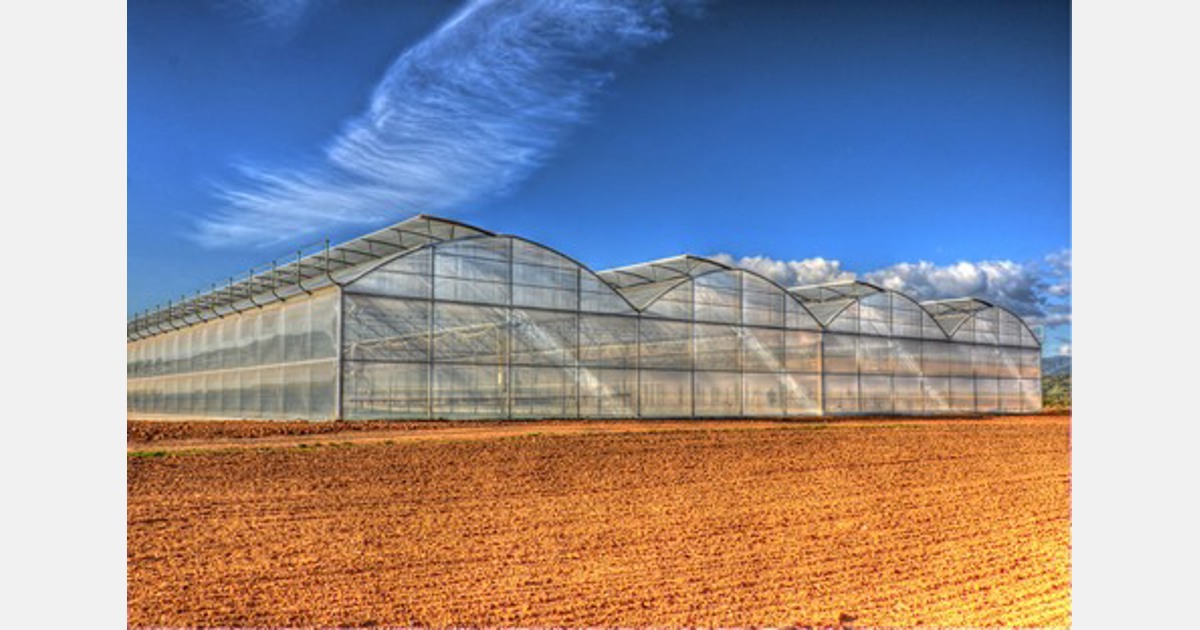Neoms food company plans to build 100 ha greenhouse project in Saudi Arabia
Neoms food company plans to build 100 ha greenhouse project in Saudi Arabia hortidaily.com



Saudi Arabian Company Signs MOU for Hydroponic Greenhouse Project
Saudi Arabian company Tabuk Agricultural Development Co. has signed a (non-binding) memorandum of understanding with TOPIAN Limited Company, (NEOM’s Food Company) for cooperating to plan, develop, construct, and operate hydroponic greenhouse for the production of fruits and vegetables in Tabuk, Saudi Arabia.
Main Obligations and Responsibilities
- Tabuk Agriculture Development Co is tasked with sourcing 100 hectares of agricultural land suitable for constructing a mid-tech hydroponic vegetable facility in a suitable location in Tabuk.
- The land must have sufficient water and electricity for the project’s needs.
- Integration of warehousing, cold store, labor, and other appropriate equipment for the project.
- Tabuk will provide support for the supervision of the facility’s construction.
Tabuk Agriculture Development Co will also assist in arranging the offtake to TOPIAN for Saudi Arabian supermarket, retail, and wholesale buyers for the products.
Responsibilities of TOPIAN
- Design and installation of the greenhouse
- Providing technical expertise in the establishment, running, and operation of the facility
- Negotiating and placing contracts for all indoor growing, greenhouse, packing, and grading supplies
- Defining the production plan and managing customer relations
- Assisting in the recruitment, supervision, and management of the workforce
- Providing training to the local workforce
- Securing the sale and distribution of all production from the facility
This memorandum is valid for one year from the date of signing or until a binding agreement is reached.
NEOM and Topian
NEOM, the Saudi megaproject developer, launched the food company Topian in December 2023 to focus on food production and distribution. Topian is supported by the Saudi Environment, Water & Agriculture Ministry to work towards the kingdom’s food security goals. The company explores sustainable and innovative food solutions, including climate-proof agriculture; regenerative aquaculture; novel foods; personalized nutrition; sustainable food supply; and environmental, social, and corporate governance issues.
NEOM comprises four ‘megacities’ and is perhaps most well-known for its mirrored city THE LINE. Currently under construction, the 170-kilometer-long ‘ground scraper’ is planned to be car-free and powered by 100 percent renewable energy. The recently announced greenhouse facilities will further NEOM’s self-sustaining vision. Earlier on, NEOM contracted Dutch greenhouse company Van Der Hoeven in an effort to introduce flourishing gardens amidst the arid deserts of Saudi Arabia, to further their self-sustaining vision.
About Tabuk Agriculture Development Company (TADCO)
Tabuk Agriculture Development Company (TADCO) is an agricultural company in the Middle East and North Africa (MENA), managing its operations regionally from Tabuk city in the northwest of Saudi Arabia, where its core operations run on a 35,000-hectare farm.
SDGs, Targets, and Indicators Analysis
1. Which SDGs are addressed or connected to the issues highlighted in the article?
- SDG 2: Zero Hunger – The article mentions that NEOM’s Food Company, Topian, is supported by the Saudi Environment, Water & Agriculture Ministry to work towards the kingdom’s food security goals.
- SDG 7: Affordable and Clean Energy – The article states that the hydroponic greenhouse facility in Tabuk, Saudi Arabia, will require sufficient water and electricity for its operation.
- SDG 8: Decent Work and Economic Growth – The article mentions that Tabuk Agriculture Development Co. will provide support for the supervision of the construction of the facility and assist in arranging the offtake to Topian for Saudi-Arabian supermarket, retail, and wholesale buyers.
- SDG 9: Industry, Innovation, and Infrastructure – The article discusses the construction and operation of a hydroponic greenhouse facility, which involves technical expertise, design, installation, and management of supplies.
- SDG 12: Responsible Consumption and Production – The article mentions that Topian explores sustainable and innovative food solutions, including sustainable food supply and environmental, social, and corporate governance issues.
- SDG 13: Climate Action – The article mentions that Topian explores sustainable food solutions, including climate-proof agriculture.
- SDG 17: Partnerships for the Goals – The article highlights the cooperation between Tabuk Agricultural Development Co. and Topian for the planning, development, construction, and operation of the hydroponic greenhouse facility.
2. What specific targets under those SDGs can be identified based on the article’s content?
- SDG 2.4: By 2030, ensure sustainable food production systems and implement resilient agricultural practices that increase productivity and production, that help maintain ecosystems, that strengthen capacity for adaptation to climate change, extreme weather, drought, flooding, and other disasters, and that progressively improve land and soil quality.
- SDG 7.2: By 2030, increase substantially the share of renewable energy in the global energy mix.
- SDG 8.5: By 2030, achieve full and productive employment and decent work for all women and men, including for young people and persons with disabilities, and equal pay for work of equal value.
- SDG 9.4: By 2030, upgrade infrastructure and retrofit industries to make them sustainable, with increased resource-use efficiency and greater adoption of clean and environmentally sound technologies and industrial processes.
- SDG 12.2: By 2030, achieve the sustainable management and efficient use of natural resources.
- SDG 13.2: Integrate climate change measures into national policies, strategies, and planning.
- SDG 17.17: Encourage and promote effective public, public-private, and civil society partnerships, building on the experience and resourcing strategies of partnerships.
3. Are there any indicators mentioned or implied in the article that can be used to measure progress towards the identified targets?
- Indicator for SDG 2.4: Proportion of agricultural area under productive and sustainable agriculture.
- Indicator for SDG 7.2: Renewable energy share in total final energy consumption.
- Indicator for SDG 8.5: Employment-to-population ratio.
- Indicator for SDG 9.4: CO2 emissions per unit of value added.
- Indicator for SDG 12.2: Domestic material consumption per capita.
- Indicator for SDG 13.2: Number of countries that have communicated the establishment or operationalization of an integrated policy/strategy/plan that increases their ability to adapt to the adverse impacts of climate change.
- Indicator for SDG 17.17: Amount of United States dollars committed to public-private and civil society partnerships.
4. Table: SDGs, Targets, and Indicators
| SDGs | Targets | Indicators |
|---|---|---|
| SDG 2: Zero Hunger | 2.4: By 2030, ensure sustainable food production systems and implement resilient agricultural practices that increase productivity and production, that help maintain ecosystems, that strengthen capacity for adaptation to climate change, extreme weather, drought, flooding, and other disasters, and that progressively improve land and soil quality. | Proportion of agricultural area under productive and sustainable agriculture. |
| SDG 7: Affordable and Clean Energy | 7.2: By 2030, increase substantially the share of renewable energy in the global energy mix. | Renewable energy share in total final energy consumption. |
| SDG 8: Decent Work and Economic Growth | 8.5: By 2030, achieve full and productive employment and decent work for all women and men, including for young people and persons with disabilities, and equal pay for work of equal value. | Employment-to-population ratio. |
| SDG 9: Industry, Innovation, and Infrastructure | 9.4: By 2030, upgrade infrastructure and retrofit industries to make them sustainable, with increased resource-use efficiency and greater adoption of clean and environmentally sound technologies and industrial processes. | CO2 emissions per unit of value added. |
| SDG 12: Responsible Consumption and Production | 12.2: By 2030, achieve the sustainable management and efficient use of natural resources. | Domestic material consumption per capita. |
| SDG 13: Climate Action | 13.2: Integrate climate change measures into national policies, strategies, and planning. | Number of countries that have communicated the establishment or operationalization of an integrated policy/strategy/plan that increases their ability to adapt to the adverse impacts of climate change. |
| SDG 17: Partnerships for the Goals |
Behold! This splendid article springs forth from the wellspring of knowledge, shaped by a wondrous proprietary AI technology that delved into a vast ocean of data, illuminating the path towards the Sustainable Development Goals. Remember that all rights are reserved by SDG Investors LLC, empowering us to champion progress together. Source: hortidaily.com
Join us, as fellow seekers of change, on a transformative journey at https://sdgtalks.ai/welcome, where you can become a member and actively contribute to shaping a brighter future.
|








